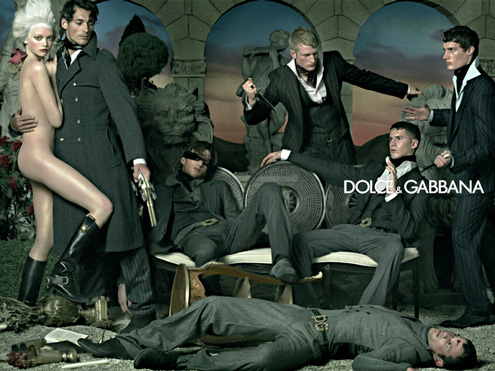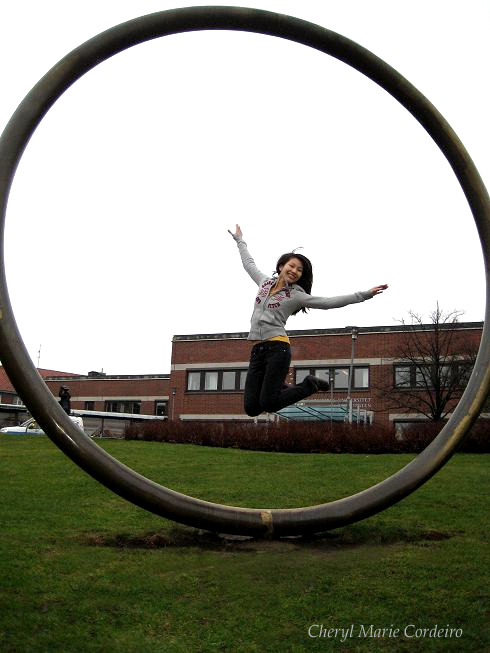Me, outside of the University of Gothenburg
about 5 minutes after I have left the final version of my PhD thesis to the printers.
Text & Photo © JE Nilsson, CM Cordeiro-Nilsson, Sweden 2009
The beginnings of profiling Scandinavian leaders in Asia: the 6 categories
The experience of being and working in a foreign city is like a juxtaposition of realities. It’s difficult not to impose what you already know from before, to the here, now and the Other. Photo by Doug Keyes, from his Becoming Language series.
In 2004, I had the opportunity to network and meet up with about 33 Swedish leaders (CEOs, MDs, regional managers, managers etc.) and their Asian counterparts. They all worked in Swedish related or Swedish owned organizations in Singapore, some of which being Ikea (I think almost all Singaporeans have something from Ikea these days, they have just opened a 2nd megastore on that tiny city island!), Sony Ericsson, Kvaerner E&C and ASSAB.
In search of the Singapore management style
A Singapore print by Charlotte, principal artist and creative director of Lotti Lane. The myriad of colours captures the multi-cultural fabric of Singapore.
Singapore: a nation with a multi-cultural fabric
With its immigrant beginnings, Singapore has long struggled with the forming of a national identity. The Chinese were the largest immigrant group during the 1800s and early 1900s. Hailing mostly from the south of China, where they had very strong ties and loyalty to mainland China in the beginning. Many never thought of permanently settling in Singapore, but hoped to return one day to China. And when money was made in Singapore, it was often remitted to families back in China. Today, the Chinese make up about 75% of the Singapore population.
The natives of the land were the Malays, who today make up approximately 14% of the population. And Singapore had immigrants from India and other parts of the world, such as the Arabs, Portuguese, British, Dutch etc. The Indians form about 9% of the population and the ‘Others’ including the Eurasians (European-Asian descendants) make up about 2% of the current population. The multi-racial fabric is also reflected in Singapore’s four official languages, which are Malay, Mandarin, Tamil and English.
Swedish management: its research beginnings, characteristic traits and style

Field in Mölle, Sweden.
Text & Photo © CM Cordeiro 2014
The Swedish management concept made headlines in 2001, as only sports news can do, when the BBC news reported that Swedish soccer manager Sven Goran Eriksson took England to the top in the World Cup qualifying rounds using Swedish management ideology.
As a field of research, studies on Swedish management is relatively new, beginning in the 1980s with research in the area of Scandinavian management. A prominent piece of work in the field at that time was Skandinaviskt management i og uden for Skandinavien by Geert Hofstede.
And in 1985, Jan Carlzon’s success as CEO (1980 – 1993) of Scandinavian Airlines (SAS) led to his book entitled Riv pyramiderna!, which mapped SAS’s winning management strategy under his leadership. His success and work gained much media attention and created a Scandinavian leadership ideal. Carlzon’s main idea was to lateralize hierarchies and decentralize decision-making within the organization, which empowered employees further out in the service line to serve customers better. With decentralization, employees were given the power to make decisions on the spot, without having to go to their managers to ask for decision approvals. And since they knew the customers better, Carlzon was convinced that the people ‘out there’ would fit best in making the right decisions regarding their work situations. The lateralization process had its problems and hiccups, one of which was the consequence of making middle managers feel rather redundant and had to be reassigned duties.
Sweden’s growing trade with Asia and it’s trade presence in Singapore

A view of the Merlion at the Esplanade, Singapore.
An interconnected world
The world is becoming an increasingly small place to live in, we can feel it in the pace at which the world economy runs these days. World trade is much larger, faster and more intense than what we knew even from 1819 when Sir Stamford Raffles founded Singapore as a trade entrepôt. Many organizations today are multinational in nature in order to compete on the global scene. Employees in such organizations are often located away from home countries in order to continue the work of the organization on a global scale, contributing to the existence, expansion and success of the organization.
Organizations going global would also mean that their people would be working on a global stage, having colleagues from foreign countries. It would mean working with someone who not only looks physically different from yourself but who share a different set of values, taken-for-granted assumptions and collectively shared beliefs, in other words, a different ideology (Simpson, 1993).
These collectively shared beliefs or ideology, stem from their own socio-cultural and political background and working together would mean communicating on a daily basis about work projects, negotiating meaning with each other so that each one understands what the other wants, the aim of which is to push the organization forward in reaching its goal.
Individuals who are often deployed to an overseas organization affiliate from their home country would often possess specialized knowledge, expertise and leadership skills, so that they can help set up and steer the affiliate organization in the new country.
The case of Sweden
Sweden for example, is today more active in terms of setting up businesses and business affiliates overseas than ever before. For example, in Eastern Europe, Sweden has 900 organizations in Estonia, 500 in Latvia and 150 in Lithuania. With its current trading figures, Asia seems to hold the most promising trade for Sweden: China in 2005 for example had 44,000 Chinese employed in Swedish organizations with an annual intake of 7.9 billion US dollars and Sweden’s presence in China since 2003 has also doubled (Serger Schwaag and Widman, 2005).
The fast-growing markets for Swedish exports today are found in Asia, especially Japan, China, Hong Kong, South Korea, Malaysia and Singapore. Asia now accounts for 13 percent of Swedish exports, making it the most important single region outside of Europe. As Asia is one of the fastest growing markets for Swedish exports, the increasing Scandinavian and Asian international trade relations mean a need for a better understanding of management styles and working relations in the interdependent countries. A contributing factor to many failed cross national joint ventures and start-ups is due to a lack of understanding of international markets, cultures and management behaviour (Hill and Hellriegel, 1994; Hambrick, Li, Xin, and Tsui,2001). A greater chance of both tangible and intangible success will thus depend on understanding and acting upon the similarities and differences between management behaviour in different international markets.
Swedish trade presence and Swedish management in Singapore
With 93% literacy rate in the population and English as an administrative language (Malay is Singapore’s native language and Singapore’s national anthem for example, is written in the Malay language), Singapore proves a strong rival with Hong Kong to be Asia-Pacific’s regional hubs (Langdale, 1989) and is currently already a regional hub for many internationally based organizations (Mutalib, 2002; Teofilo and Le, 2003).
According to the 2007 statistics of the Swedish Trade Council (STC), who have been present in Singapore since 1978, there are approximately 160 Swedish or Swedish related organizations in Singapore with 900 Swedes living in Singapore. Companies included in the STC’s list are of the following three types:
- Singaporean companies which have a parent company in Sweden
- Singaporean companies that sell Swedish products and who have active joint-ventures or partnership activities with a Swedish company and
- Singaporean companies owned by Swedish citizens.
The existence of the Swedish Business Association of Singapore (SBAS) also makes easy access to Swedish owned or Swedish related organizations in Singapore. The SBAS also provides a focal point for the Swedish business community to gather and exchange ideas and continue a Swedish / Scandinavian heritage in Singapore.
References
- Hambrick, D. C. / Li, J. / Xin, K. and Tsui, A. S., 2001. Compositional gaps and downward spirals in international joint venture management groups. Strategic Management Journal, vol. 22, no. 11 (Nov. 2001), pp. 1033-1053.
- Hill, R. C and Hellriegel, D., 1994. Critical contingencies in joint venture management: some lessons from managers. Organization Science, vol. 5, no. 4 (Nov. 1994), pp. 594-607.
- Langdale, J. V., 1989. The Geography of International Business Telecommunications: The Role of Leased Networks. Annals of the Association of American Geographers, Vol. 79, No. 4, pp. 501-522. Taylor & Francis, Ltd. on behalf of the Association of American Geographers.
- Mutalib, H., 2002. The Socio-Economic Dimension in Singapore’s Quest for Security and Stability. Pacific Affairs, Vol. 75, No. 1, pp. 39-56. Pacific Affairs, University of British Columbia.
- Simpson, P., 1993. Language, Ideology and Point of View. New York: Routeledge.
- Teofilo C. D. and Le H. H., 2003. Singapore and ASEAN in the global economy: the case of free trade agreements. Asian Survey, Vol. 43, No. 6, pp. 908-928. University of California Press.

Fashion: an expression of Hegelian geist

Oyster Dress by Alexander McQueen for S/S 2003. Ivory silk chiffon and silk organza.
 I’ve been revisiting Addressing Fashion by the Metropolitan Museum of Art (the avatar to the left will bring you to the MM’s website) and have picked out my favourite pieces from the their exhibition, to write about in this post. This is a subconscious streaming of thoughts, as it were, back on my favourite ponder on fashion, its connection to language, inspiration, geist and towards an understanding of a people.
I’ve been revisiting Addressing Fashion by the Metropolitan Museum of Art (the avatar to the left will bring you to the MM’s website) and have picked out my favourite pieces from the their exhibition, to write about in this post. This is a subconscious streaming of thoughts, as it were, back on my favourite ponder on fashion, its connection to language, inspiration, geist and towards an understanding of a people.
My favourite pieces from this exhibit were the ones with a fuller silhouette, with soft flowing volume; their diaphanous design and characteristic, bordering on the ethereal. Even the ash grey of Theyskens piece below didn’t pull down my spirits or enthusiasm for the dress.
The evolving concept of luxury
The definitions of luxury
Luxury is an extensive concept which connects with extravagance, prestige and elitism (Dubois and Czellar, 2002). Some standard dictionary definitions of luxury could include:
- Something inessential but conducive to pleasure and comfort.
- Something expensive or hard to obtain.
- Sumptuous living or surroundings: lives in luxury.
One could see how the above three definitions found in the American Heritage Dictionary, are intertwined and difficult to separate. A very broad definition of what is luxury, from Coco Chanel reflects this interlacing of definitions to form a concept of luxury: “Luxury is a necessity that begins when necessity ends” (Gradvall, 2007).
Dolce & Gabanna: Lets do street violence in style, 2007

A banned D&G advertisement for Fall/Winter 2006.
In a Stockholm newspaper DN October 30, 2007 were an interesting article on redefining luxury, it’s changing premises and its spreading to the middle class rather than being exclusive to the “absurdly affluent”. I can’t help seeing the new D&G advertising for their latest collection in this light. It is quite obvious that they are trying to reach a different crowd than those who bought the original LV bags of the 1920s and crossed the Atlantic twice a year to spend the summer season in France, so much is clear.
Print advertisements for Dolce & Gabbana (D&G) clothing, fashionably un-affective in expression but featuring a knifing, have been banned in Britain by UK’s Advertising Standards Authority after drawing 166 complaints. D&G explained that its latest collection was designed to evoke the Napoleonic period and that the related advertisement took its inspiration from well-known paintings by Delacroix and David. The advertisements had run in the US, Europe, China, Hong Kong and Japan without complaint.
A critical think: the James Watson DNA debate

Photo: Edmond Terakopian/PA
I’ve read in the past few days, the following three news articles on James Watson. The 79 year old is a Nobel Prize winner (1962) and has served for 50 years as a director of the Cold Spring Harbour Laboratory on Long Island. He is considered a world leader in research into cancer and genetics. What I write in this post is based on these three articles I’ve thus read.
A diamond skull is forever

British artist Damien Hirst revealed his latest work of art at the White Cube Gallery in London, June 1, 2007. “For the Love of God” is a life-size cast of a human skull in platinum and covered by 8,601 pave-set diamonds weighing 1,106.18 carats. The single large diamond in the middle of the forehead is a 52.4 carat internally flawless, light, fancy pink, brilliant-cut diamond reportedly worth $4.2 million alone. Hirst financed the project himself, and estimates it cost between 10 and 15 million. The price tag was $99 million. The platinum plates were hand-lasered with thousands of holes and the diamonds, which have a total weight of 1,106.18 carats, were individually set.
When I first saw this skull I went through a myriad of reactions that went something like:
WOW! What a fantastic thing!
Oooh! How HORRID!
buuuuut…Interesting.
COOOOOL!
Well, my thoughts needed to do a really long walking to come to that fourth observation of it being cool. The obvious in-your-face impression of this piece of art, is of course that the skull as an age old Vanitas symbol that Nothing is Forever, combined with the De Beer diamond slogan that Diamonds, are Forever, Hirst manages to add some kind of cynical humour to the combination “Death, is Forever, too”.
How cool is that.
Then I started to wonder, is that observation really worth £50 million?
My mind started to ponder a much wider circle. Looking some into this I found that the original “perfectly shaped skull” had been sourced from a taxidermy shop, with an analysis suggesting that it had probably belonged to a European man who died in his mid-thirties in the 18th or early 19th century.
But don’t those teeth awfully “fresh” to be from an 18th century skull?

A really old skull. The painting “Vanitas” by, Pieter Claesz (1597-1661).
It suddenly dawned on me that I had seen such a “fresh” looking skull once before, at the desk of an engineer who designed dental equipment. “Is this plastic?”, I asked. “No, it’s the real thing” he answered and explained that it actually came from the first World War battle fields in the Flanders. They were popular with dental clinics because the soldiers had been so young and healthy when they died, that their teeth were perfect, “Look Ma, no cavities!”.
Of course this was just my mind wandering, but then again I had just been forced – due to a lack of alternatives – to read an article about a specifically bloody battle in an obscure village in Belgium, called Passchendaele. It lasted some 100 days in the autumn of 1917. And when it ended, a total of 325,000 Allied and 260,000 German young men had died, achieving nothing.



